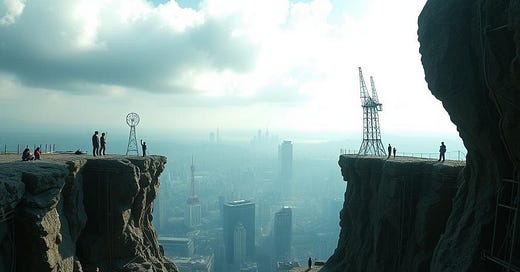ME03b: From Self to System - The Real Terrain of Grown-Up Leadership
Why leadership development can’t stop at the self.
Maya had stopped trying to ascend.
Not because she didn’t believe in growth. She did. But because she’d seen where the ladder led. And what it couldn’t reach.
She still practised reflection. Still asked hard questions. But she no longer believed that development was something she could climb her way through—especially not alone.
Because every time she became more coherent, the system stayed incoherent. And every time she tried to move differently, the ground beneath her slipped.
That’s when she realised something quietly devastating. Even the most reflective, self-authored, developmentally aware leader can be undone by a system that doesn’t recognise what they’re trying to do.
The Complexity Gap Has a Weight
It was a phrase that stopped her cold: The Complexity Gap.
She found it in a paper by Theo Dawson. The idea was simple and brutal: the gap is the distance between the complexity of the challenges you're facing and the developmental capacity you currently possess.
It wasn’t a metaphor. It was a diagnosis.
You’re not failing because you’re weak. You’re failing because the role has outgrown the scaffolding you’ve been given to hold it.
That’s what Maya had been feeling for months. The sense that she was trying to navigate something more layered, more political, more fluid than any leadership model had prepared her for. And that her efforts to stay upright, let alone lead, were demanding more emotional, cognitive, and relational bandwidth than she had available.
She began to realise that this wasn’t burnout. It was design failure. Once she had the words for it, she couldn’t unsee it.
When Growth Hits Structural Limits
Maya went looking again. Not for another personality model or mindset framework, but for a way to understand how people grow through complexity.
That’s when she found the vertical development thinkers: Theo Dawson, Jennifer Garvey Berger, Nick Petrie, Jonathan Reams. They weren’t talking about traits. They were mapping how adults build capacity to hold ambiguity, see systems, and act with discernment.
The models were good. Rigorous. Grounded. Earnest. They spoke of sensemaking. Perspective maturity. Adaptive capability.
But as Maya read more, she began to feel something else: a different kind of fatigue. The skill maps were overwhelming—dozens of levels, sub-levels, diagnostic grids. It felt like a taxonomy of transcendence. And none of it told her what to do when her Thursday morning started with a budget shortfall, a team conflict, and a global VP asking for strategic clarity by 4pm.
She believed in the ideas. But they weren’t landing in the heat of practice.
That’s when she realised: she didn’t need more granularity. She needed something load-bearing. A framework that wouldn’t collapse under pressure. A support structure she could feel when things got messy.
Anchoring in Connection
Then, almost by accident, she found it.
A short paper. Clean. Quiet. Humane. Becky Andree, writing on High-Quality Connections. Brief, positive interactions that create trust, openness, and relational energy.
Not another model to master. Just an invitation to notice what actually shifts people. What opens systems. What enables capacity.
It wasn’t in keynotes. It wasn’t in slide decks. It was in small, unnoticed moments.
A walk after a hard meeting.
A message that simply said, “You okay?”
A laugh in the pantry that softened the air.
Maya paused. These were things she was already doing. She just hadn’t recognised them as leadership. Because no one ever called them that.
But they were.
They were how trust moved.
They were how risk became tolerable.
They were how growth happened between people, not just within them.
The System as Performance
That changed her focus.
She stopped looking for a better self. She started watching the system. Not the formal one—the charts, the policies, the strategy decks. The real one. The network of expectations, unspoken rules, and relational choreography.
She started asking different questions:
What happens before a decision flows smoothly?
Where is trust quietly breaking down?
Who’s doing the invisible labour of sensemaking and who gets credit for it?
She stopped looking for stars. She began listening for signal.
That’s when it hit her: Leadership wasn’t just an act inside a system. It was a way of tuning the system itself. Through presence. Through phrasing. Through timing.
It wasn’t just about leading people. It was about shaping the patterns between them.
A New Developmental Hypothesis
Maya no longer believed the most developed leader was the one who could perform clarity in chaos. She believed it was the one who could hold a room long enough for something better to emerge. Who could make others feel seen, even when there was no solution. Who could let ambiguity breathe without collapsing into control or retreat.
And she noticed something else. Those leaders weren’t just growing in themselves. They were growing others in real time. By sharing attention. By metabolising tension. By anchoring connection where the system wanted to fragment.
That, she realised, was a different kind of development. Not a higher stage or aspirations of trascendental conciousness. But a deeper coherence. Importantly, vitally, a coherence anchored in the real.
What If Growth Isn’t Personal?
The question shifted again.
What if leadership development isn’t personal at all?
What if it's not about “being a better version of yourself,” but about building system capacity—relational, emotional, strategic.
And what if high-quality connection isn't a soft skill? What if it’s infrastructure?
The thing that enables adaptation.
The thing that allows dissent.
The thing that makes intelligence collective.
Because maybe the real work isn’t becoming the leader the models admire. Maybe it’s becoming the leader the system can actually hold. Or better yet: the leader who helps the system hold itself together when the pressure rises.
The End of the Ladder
Maya doesn’t reject growth. She just no longer needs it to look like progress.
She’s not interested in transcendence. She’s interested in traction. Not in looking down from a higher stage but in looking around and knowing what to do next.
And when she forgets, she comes back to something small:
Am I creating the conditions where others can grow?
Am I attuning to the real system, not just the official one?
Am I staying present, even when the script disappears?
Because if that’s development, it’s something she can practice. Something she can share. And maybe, something that changes the system too.\
SELF → Where am I mistaking insight for impact?
You’ve done the work. You see the system more clearly. But where has that clarity quietly stalled, because the conditions to act haven’t changed?
→ Reflect on moments where your developmental awareness has outpaced your ability to influence. What did you feel? What did you do? What did you perform?
ROLE → What system am I actually tuning through this role?
Forget the org chart for a moment. Your role is already shaping flows of trust, energy, and meaning.
→ Ask: What relational patterns am I stabilising—or disturbing? What becomes possible (or impossible) because of how I show up?
SYSTEM → Where is growth happening between people—not inside them?
Many systems still treat development as a solo journey. But connection can be scaffolding.
→ Where do trust, presence, or micro-moments shift performance more than any model? What would it mean to treat those interactions as infrastructure?
If this resonates, don’t start by rewriting yourself. Start by noticing what’s already shifting—between you, around you, because of you.
Pay attention to connection.
Track what your role is really tuning.
And ask: what kind of system becomes possible if we stop climbing—and start attuning?
Let me know what you’re noticing. I’d love to hear.






Oh my gosh!!!! This is so wonderful I feel like I have been grappling something for years and you have just given me the language and the conceptual framework to think about it. Hallelujah!!! You even explain my deep frustration with leadership development in a way that finally makes sense.
I was going to say that I don’t meet many people who would ‘get’ this but that isn’t quite right. There are many people who feel it. They can’t articulate why but when asked they can point to a leader or a team experience where this kind of leadership was being practiced. They yearn to experience it again and mourn its loss.
You have opened up the world again Richard and I can’t thank you enough.